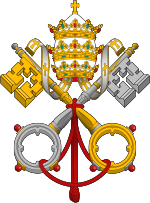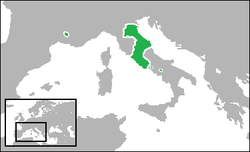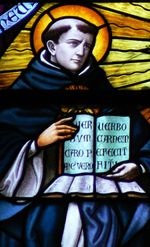Papal States
|
|||||||||||||||||||||||||||||||||||||||||||||
The Papal State(s), State(s) of the Church, or Pontifical States (Italian: Stato Pontificio, also Stato della Chiesa, Stati della Chiesa, Stati Pontifici, and Stato Ecclesiastico; Latin: Status Pontificius, also Dicio Pontificia) were one of the major historical states of Italy from roughly the 6th century until the Italian peninsula was unified in 1861 by the Kingdom of Piedmont-Sardinia (after which the Papal States, in less territorially extensive form, continued to exist until 1870).
The Papal States comprised territories under direct sovereign rule of the papacy, and at its height it covered most of the modern Italian regions of Romagna, Marche, Umbria and Lazio. This governing power is commonly called the temporal power of the Pope, as opposed to his ecclesiastical primacy.
The plural Papal States is usually preferred; the singular Papal State (equally correct since it was not a mere personal union) is rather used (normally with lower-case letters) for the modern State of Vatican City, an enclave within Italy's national capital, Rome. Vatican City was founded in 1929, again allowing the Holy See the political benefits of territorial sovereignty.
Origins
It would, however, be wrong to suppose that all papal claims of secular jurisdiction, taxation and service, etc. were exactly defined, or that they applied with equal force all over a large region of central Italy, or that local warlords or others readily conceded obedience to Rome. This was no modern state yet, no equivalent to the contemporary strong monarchies of France or England. Force of tradition and forceful possession counted more than written deeds of donation.
–D.S. Chambers[1]
The Christian Church spent its first three centuries as an outlawed organization and was thus unable to hold or transfer property. Early Christian churches congregated in the audience halls of well-to-do individuals, and a number of Early Christian churches built round the edges of Ancient Rome were ascribed to patrons who held the property in custody for the Church: see titulus. After the ban was lifted by the Emperor Constantine I, the Church's private property grew quickly through the donations of the pious and the wealthy; the Lateran Palace was the first significant donation, a gift of Constantine himself.
Other donations soon followed, mainly in mainland Italy but also in the provinces, but the Church held all of these lands as a private landowner, not as a sovereign entity. When in the fifth century the Italian peninsula passed under the control of first Odoacer and then the Ostrogoths, the church organization in Italy, and the bishop of Rome as its head, submitted to their sovereign authority while beginning to assert spiritual supremacy.
The seeds of the Papal States as a sovereign political entity were planted in the sixth century. The Eastern Roman (or Byzantine) government in Constantinople launched a reconquest of Italy that took decades and devastated the country's political and economic structures; just as those wars wound down, the Lombards entered the peninsula from the north and conquered much of the countryside. By the seventh century, Byzantine authority was largely limited to a diagonal band running roughly from Ravenna, where the Emperor's representative, or Exarch, was located, to Rome and south to Naples (the "Rome-Ravenna corridor").
With effective Byzantine power weighted at the northeast end of this territory, the Bishop of Rome, as the largest landowner and most prestigious figure in Italy, began by default to take on much of the ruling authority that Byzantines were unable to project to the area around the city of Rome. While the Bishops of Rome — now beginning to be referred to as the Popes — remained de jure Byzantine subjects, in practice the Duchy of Rome, an area roughly equivalent to modern-day Latium, became an independent state ruled by the Church.
The Church's independence, combined with popular support for the Papacy in Italy, enabled various Popes to defy the will of the Byzantine emperor; Pope Gregory II even excommunicated emperor Leo III the Isaurian. Nevertheless the Pope and the Exarch still worked together to control the rising power of the Lombards in Italy. As Byzantine power weakened, though, the Papacy took an ever larger role in defending Rome from the Lombards, usually through diplomacy, threats and bribery. In practice, the papal efforts served to focus Lombard aggrandizement on the Exarch and Ravenna. A climactic moment in the founding of the Papal States was the agreement over boundaries embodied in the Lombard king Liutprand's Donation of Sutri (728) to Pope Gregory II [1].
The Donation of Pepin
When the Exarchate finally fell to the Lombards in 751, the Duchy of Rome was completely cut off from the Byzantine Empire, of which it was theoretically still a part. Pope Stephen II acted to neutralize the Lombard threat by courting the de facto Frankish ruler, Pepin the Short. With the urging of Pope Zachary to depose the Merovingian figurehead Childeric III, Pepin was crowned in 751 by Saint Boniface.
Stephen later granted Pepin the title Patrician of the Romans. Pepin led a Frankish army into Italy in 754 and 756. Pepin defeated the Lombards — taking control of northern Italy — and made a gift (called the Donation of Pepin) of the properties formerly constituting the Exarchate of Ravenna to the Pope.
In 781, Charlemagne codified the regions over which the Pope would be temporal sovereign: the Duchy of Rome was key, but the territory was expanded to include Ravenna, the Pentapolis, parts of the Duchy of Benevento, Tuscany, Corsica, Lombardy and a number of Italian cities. The cooperation between the Papacy and the Carolingian dynasty climaxed in 800, when Pope Leo III crowned Charlemagne the first "Emperor of the Romans" ('Augustus Romanorum').
However, the precise nature of the relationship between the Popes and Emperors — and between the Papal States and the Empire — was not clear. Was the Pope a sovereign ruler of a separate realm in central Italy, or were the Papal States just a part of the Frankish Empire over which the Popes had administrative control? Or were the Holy Roman Emperors vicars of the Pope (as a sort of Archemperor) ruling Christendom, with the Pope directly responsible only for the environs of Rome and spiritual duties?
Relationship with the Holy Roman Empire
Events in the 9th century postponed the conflict: the Frankish Empire collapsed as it was subdivided among Charlemagne's grandchildren, and the papacy's prestige declined, with the tyranny of the local Roman nobility in the tenth century, into the condition later dubbed the pornocracy, or "rule by harlots".[2] In practice, the Popes were unable to exercise effective sovereignty over the extensive and mountainous territories of the Papal States, and the region preserved its old Lombard system of government, with many small countships and marquisates, each centered upon a fortified rocca.
Over several campaigns in the mid-tenth century, the German ruler Otto I conquered northern Italy; Pope John XII crowned him emperor (the first so crowned in more than forty years), and the two of them ratified the Diploma Ottonianum, which guaranteed the independence of the Papal States. Yet over the next two centuries, Popes and Emperors squabbled over a variety of issues, and the German rulers routinely treated the Papal States as part of their realms on those occasions when they projected power into Italy. A major motivation for the Gregorian Reform was to free the administration of the Papal States from imperial interference, and after the extirpation of the Hohenstaufen dynasty, the German emperors rarely interfered in Italian affairs. By 1300, the Papal States, along with the rest of the Italian principalities, were effectively independent.
Period of the Avignon papacy
From 1305 to 1378, the Popes lived in the papal enclave of Avignon, surrounded by Provence, and were under the influence of the French kings in the 'Babylonian Captivity'. During this Avignon Papacy, local despots took advantage of the absence of the popes, to establish themselves in nominally papal cities: the Pepoli in Bologna, the Ordelaffi in Forlì, the Manfredi in Faenza, the Malatesta in Rimini all gave nominal acknowledgement to their papal overlords and were declared vicars of the Church.
In Ferrara, the death of Azzo VIII d'Este without legitimate heirs (1308) encouraged Clement to bring Ferrara under his direct rule: for only nine years, however, was it governed by his appointed vicar, Robert d'Anjou, King of Naples, before the citizens recalled the Este from exile (1317); interdiction and excommunications were in vain: in 1332 John XXII was obliged to name three Este brothers as his vicars in Ferrara.
In Rome itself the Orsini and the Colonna struggled for supremacy, dividing the city's rioni between them. the resulting aristocratic anarchy in the city provided the setting for the fantastic dreams of universal democracy of Cola di Rienzo, who was acclaimed Tribune of the People in 1347 and met a violent death in 1354.
The Rienzo episode engendered renewed attempts from the absentee papacy to re-establish order in the dissolving Papal States, resulting in the military progress of Cardinal Egidio Albornoz, who was appointed papal legate, and his condottieri heading a small mercenary army. Having received the support of the archbishop of Milan and Giovanni Visconti, he defeated Giovanni di Vico, lord of Viterbo, moving against Galeotto Malatesta of Rimini and the Ordelaffi of Forlì, the Montefeltro of Urbino and the da Polenta of Ravenna, and against the cities of Senigallia and Ancona. The last holdouts against full papal control were Giovanni Manfredi of Faenza and Francesco II Ordelaffi of Forlì. Albornoz, at the point of being recalled in 1357, in a meeting with all the Papal vicars, 29 April 1357, promulgated the Constitutiones Sanctæ Matris Ecclesiæ, which replaced the mosaic of local law and accumulated traditional 'liberties' with a uniform code of civil law. These Constitutiones Egidiane mark a watershed in the legal history of the Papal States; they remained in effect until 1816. Pope Urban V ventured a return to Italy in 1367 that proved premature; he returned to Avignon in 1370
During this period the city of Avignon itself was added to the Papal States; it remained a papal possession even after the popes returned to Rome, being seized and incorporated into the by then unitary French state only during the French Revolution.
The Renaissance
During the Renaissance, the papal territory expanded greatly, notably under Popes Alexander VI and Julius II. The Pope became one of Italy's most important secular rulers as well as the head of the Church, signing treaties with other sovereigns and fighting wars. In practice, though, most of the Papal States was still only nominally controlled by the Pope, and much of the territory was ruled by minor princes. Control was always contested; indeed it took until the 16th century for the Pope to have any genuine control over all his territories.
At its greatest extent, in the 18th century, the Papal States included most of Central Italy — Latium, Umbria, Marche and the Legations of Ravenna, Ferrara and Bologna extending north into the Romagna. It also included the small enclaves of Benevento and Pontecorvo in southern Italy and the larger Comtat Venaissin around Avignon in southern France.
French Revolution and Napoleonic era

The French Revolution proved as disastrous for the temporal territories of the Papacy as it was for the Roman Church in general. In 1791 the Comtat Venaissin and Avignon were annexed by France. Later, with the French invasion of Italy in 1796, the Legations were seized and became part of the revolutionary Cisalpine Republic.
Two years later, the Papal States as a whole were invaded by French forces, who declared a Roman Republic. Pope Pius VI died in exile in France in 1799. The Papal States were restored in June 1800 and Pope Pius VII returned, but the French again invaded in 1808, and this time the remainder of the States of the Church were annexed to France, forming the départements of Tibre and Trasimène.
With the fall of the Napoleonic system in 1814, the Papal States were restored once more. From 1814 until the death of Pope Gregory XVI in 1846, the Popes followed a harshly reactionary policy in the Papal States. For instance, the city of Rome maintained the last Jewish ghetto in Western Europe. There were hopes that this would change when Pope Pius IX was elected to succeed Gregory and began to introduce liberal reforms.
Italian nationalism and the end of the Papal States
Italian nationalism had been stoked during the Napoleonic period but dashed by the settlement of the Congress of Vienna (1814–15), which left Italy divided: aside from Sardinia-Piedmont, Tuscany and the north were under rule of junior cadet branches of the Habsburgs and in the south the Kingdom of the Two Sicilies was under Bourbon rule. In 1848, nationalist and liberal revolutions began to break out across Europe; in 1849, a Roman Republic was declared and Pope Pius IX fled the city.

On September 10, 1870, Italy declared war on the Papal States, and the Italian Army, commanded by General Raffaele Cadorna, crossed the frontier of the then remaining papal territory on 11 September and advanced slowly toward Rome. The Italian Army reached the Aurelian Walls on 19 September and placed Rome under a state of siege. Although the pope's tiny army was incapable of defending the city, Pius IX ordered it to put up at least a token resistance to emphasize that Italy was acquiring Rome by force and not consent. This incidentally served the purposes of the Italian State and gave rise to the myth of the Breach of Porta Pia, in reality a tame affair involving a cannonade at close range that demolished without much fuss an ancient wall in poor repair. The city was captured on September 20, 1870. Rome and Latium were annexed to the Kingdom of Italy as a result of a plebiscite the following October of the sort that the expanding Sardinian and then Italian state had devised over the course of the nineteenth century.
The new Italian control of Rome did not wither, as Pius IX had expected, nor did the traditionally Catholic powers come to the Pope's aid, as he had hoped against bitter experience. So as not to prejudice a political outcome at some future date, the papacy rejected any substantial accommodation with the Italians and confined itself to the Apostolic Palace and adjacent buildings in the loop of the ancient fortifications known as the Leonine City, on Vatican Hill. From there it maintained a number of features pertaining to sovereignty, such as diplomatic relations, since in canon law these were inherent in the papacy. In the 1920s, the papacy — then under Pius XI — renounced the bulk of the Papal States and the Lateran Treaty (or Concordat) with Italy was signed on February 11, 1929, creating the State of the Vatican City, forming the sovereign territory of the Holy See, which was also indemnified to some degree for loss of territory.
Institutions

- As the plural name Papal States indicates, the various regional components, usually former independent states, retained their identity under papal rule. The Pope was represented in each province by a governor, either styled papal legate, as in the former principality of Benevento, or Bologna, Romagna, and the March of Ancona; or papal delegate, as in the former duchy of Pontecorvo.
- The police force, known as sbirri ("cops" in modern Italian slang), was billeted in private houses (normally a practice of military occupation) and enforced order quite rigorously.
- For the defence of the states against the nascent Italian state in the last years of papal territorial autonomy, an international Catholic volunteer corps, called Papal Zouaves after a kind of French colonial native Algerian infantry, and imitating their uniform type, was created and fought in many engagements with great courage against superior odds in men and equipment.[3]
See also
- Avignon Papacy
- Donation of Constantine
- History of Rome
- Holy Roman Empire
- Italian unification
- Prisoner in the Vatican
- War of the Eight Saints
- Captain General of the Church
References
 This article incorporates text from a publication now in the public domain: Herbermann, Charles, ed (1913). "States of the Church". Catholic Encyclopedia. Robert Appleton Company.
This article incorporates text from a publication now in the public domain: Herbermann, Charles, ed (1913). "States of the Church". Catholic Encyclopedia. Robert Appleton Company.- Chambers, D.S. 2006. Popes, Cardinals & War: The Military Church in Renaissance and Early Modern Europe. I.B. Taurus. ISBN 1-84511-178-8.
- De Cesare, Raffaele (1909). The Last Days of Papal Rome. London: Archibald Constable & Co.
- Luther, Martin (1521). Passional Christi und Antichristi. Reprinted in W.H.T. Dau (1921). At the Tribunal of Caesar: Leaves from the Story of Luther's Life. St. Louis: Concordia. (Google Books)
Footnotes
- ↑ Chambers, 2006, p. xv
- ↑ Emile Amann and Auguste Dumas, ""L'église au pouvoir des laïques", in Auguste Fliche and Victor Martin, eds. Histoire de l'Église depuis l'origine jusqu'au nos jours, vol. 7 (Paris 1940, 1948). Liutprand of Cremona's biased account is adjusted by Bernard Hamilton, "The monastic revival in tenth-century Rome" and "The House of Theophylact and the promotion of the religious life among women in tenth-century Rome", both articles collected in Hamilton's Monastic Reform, Catharism and the Crusades (900–1300 (London, 1979).
- ↑ Charles A. Coulombe, The Pope's Legion: The Multinational Fighting Force that Defended the Vatican, Palgrave Macmillan, New York, 2008
Sources, references, and external links
- WorldStatesmen: Italy
- WHKMLA Historical atlas: here the page offering numerous links to maps of/containing Italy
External links
|
||||||||||||||||||||||||||||||||||||||||||
|
|||||||||||||||||||||||||||||||||||||||||
.svg.png)



